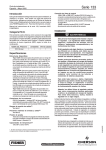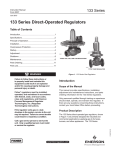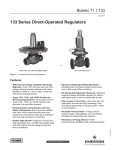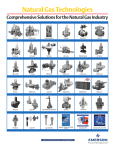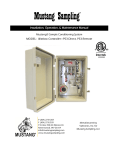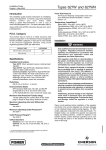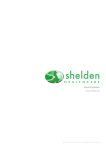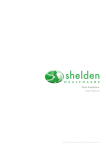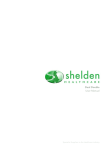Download Emerson 133 Series Pressure Reducing Regulators Installation Guide
Transcript
Installation Guide English – May 2002 133 Series Temperature Capabilities(1) Introduction This installation guide provides instructions for installation, startup, and adjustment. To receive a copy of the instruction manual, contact your local Fisher Sales Office or Sales Representative or view a copy at www.FISHERregulators.com. For further information refer to: -29 to 66°C (-20 to 150°F) Control Line Connection 133 Series Instruction Manual, form 5007, D100270X012. 133H, 133L, and 133Z: DN 20 (3/4-inch) NPT female; connection will be positioned directly over body outlet (standard position) or 90 degrees right or left of standard position if specified P.E.D. Categories 133HP: DN 8 (1/4 NPT) female connection positioned directly over body outlet This product may be used as a safety accessory with pressure equipment in the following Pressure Equipment Directive 97/23/EC categories. It may also be used outside of the Pressure Equipment Directive using sound engineering practice (SEP) per table below. PRODUCT SIZE CATEGORIES FLUID TYPE DN 50 (2-inch) I 1 Specifications Available Constructions Type 133H: High pressure construction for outlet pressure range of 1-1/2 to 10 psig (0,10 to 0,69 bar). The Type 133H can also use the 5 mbar to 0,14 bar (2-inches w.c. to 2 psig) springs of the Type 133L. The maximum operating inlet pressure is 4,1 bar (60 psig) with a maximum emergency inlet pressure of 8,6 bar (125 psig). Type 133HP: Extra high pressure construction for outlet pressure range of 0,14 to 4,1 bar (20 to 60 psig). The maximum operating inlet pressure rating of 10 bar (150 psig) with a maximum emergency inlet pressure of 10 bar (150 psig). Type 133L: Low pressure construction for outlet pressure range of 5 mbar to 0,14 bar (2-inches w.c. to 2 psig). The maximum operating inlet pressure is 4,1 bar (60 psig) with a maximum emergency let pressure of 8,6 bar (125 psig). Type 133Z: Zero gravity governor construction for outlet pressure range of -2,5 to 10 mbar (-1 to 4inches w.c.). The maximum operating inlet pressure is 1,4 bar (20 psig) with a maximum emergency inlet pressure of 8,6 bar (125 psig). End Connections DN 50 (2-inch) - cast iron NPT female, cast iron ANSI Class 125 flat-face flanged, steel NPT female, or steel ANSI Class 150 raised-face flanged Outlet Pressure Ranges(1) See table 1 Installation Only qualified personnel should install or service a regulator. Regulators should be installed, operated, and maintained in accordance with international and applicable codes and regulations, and Fisher instructions. If the regulator vents fluid or a leak develops in the system, it indicates that service is required. Failure to take the regulator out of service immediately may create a hazardous condition. Personal injury, equipment damage, or leakage due to escaping fluid or bursting of pressure-containing parts may result if this regulator is overpressured or is installed where service conditions could exceed the limits given in the Specifications section, or where conditions exceed any ratings of the adjacent piping or piping connections. To avoid such injury or damage, provide pressurerelieving or pressure-limiting devices (as required by the appropriate code, regulation, or standard) to prevent service conditions from exceeding limits. Additionally, physical damage to the regulator could result in personal injury and property damage due to escaping fluid. To avoid such injury and damage, install the regulator in a safe location. Clean out all pipelines before installation of the regulator and check to be sure the regulator has not been damaged or has collected foreign material during shipping. For NPT bodies, apply pipe compound to the male pipe threads. For flanged bodies, use suitable line gaskets and approved piping and bolting practices. Install the regulator in any position desired, unless otherwise specified, but be sure flow through the body is in the direction indicated by the arrow on the body. Maximum Inlet and Outlet Pressures(1) See table 2 Proof Test Pressure All Pressure Retaining Components have been proof tested per Directive 97/23/EC - Annex 1, Section 7.4 It is important that the regulator be installed so that the vent hole in the spring case is unobstructed at all times. For outdoor installations, the regulator should be located away from vehicular traffic and positioned so that water, ice, and other foreign materials cannot 1. The pressure/temperature limits in this installation guide and any applicable standard or code limitation should not be exceeded. www.FISHERregulators.com D100270XENG Note 133 Series enter the spring case through the vent. Avoid placing the regulator beneath eaves or downspouts, and be sure it is above the probable snow level. Table 1. Series 133 Outlet Pressure Ranges TYPE Overpressure Protection The recommended pressure limitations are stamped on the regulator nameplate. Some type of overpressure protection is needed if the actual inlet pressure exceeds the maximum operating outlet pressure rating. Overpressure protection should also be provided if the regulator inlet pressure is greater than the safe working pressure of the downstream equipment. Regulator operation below the maximum pressure limitations does not preclude the possibility of damage from external sources or debris in the line. The regulator should be inspected for damage after any overpressure condition. inches w.c. / psig 133H(1) 0.10 to 0.21 bar 0.14 to 0.34 bar 0.34 to 0.69 bar 1.5 to 3 psig 2 to 5 psig 5 to 10 psig 133HP(1) 0.14 to 0.34 bar 0.34 to 0.69 bar 0.69 to 1.4 bar 1.4 to 2.1 bar 2.1 to 2.8 bar 2.8 to 3.4 bar 3.4 to 4.1 bar 2 to 5 psig 5 to 10 psig 10 to 20 psig 20 to 30 psig 30 to 40 psig 40 to 50 psig 50 to 60 psig 133L(1) and 133H(2) 5 to 10 mbar 8.7 to 15 mbar 12 to 22.4 mbar 21.2 to 44.8 mbar 35 to 70 mbar 0.05 to 0.14 bar 2 to 4-in. w.c. 3.5 to 6-in. w.c. 5 to 9-in. w.c. 8.5 to 18-in.w.c. 14 to 28-in. w.c. 0.75 to 2 psig -2.5 to 2.5 mbar -1 to 1-in. w.c. 0 to 10 mbar 0 to 4-in. w.c. 133Z(1) Startup If the downstream system is already pressured by another regulator or by a manual bypass, then extra precautions must be taken when placing the 133 Series in service. The outlet of the regulator must never be subjected to pressures higher than the inlet pressure, or the balancing diaphragm may be damaged. Also, the control line pressure must never exceed the set point dictated by the spring setting by more than 0,21 bar (3 psig), or the valve seat or diaphragm plates can be damaged. The regulator is factory set at approximately the midpoint of the spring range or the pressure requested, so an initial adjustment may be required to give the desired results. With proper installation completed and relief valves properly adjusted, slowly open the upstream and downstream shutoff valves. Adjustment To change the outlet pressure, remove the closing cap or loosen the locknut and turn the adjusting screw clockwise to increase outlet pressure or counterclockwise to decrease pressure. Monitor the outlet pressure with a test gauge during the adjustment. Replace the closing cap or tighten the locknut to maintain the desired setting. Taking Out of Service (Shutdown) To avoid personal injury resulting from sudden release of pressure, isolate the regulator from all pressure before attempting disassembly. 2 OUTLET PRESSURE RANGE bar / mbar 1. Pressure ranges shown are correct if the regulator is installed with the actuator portion above the body portion. If the regulator is installed with the actuator portion below the body, the pressure ranges will be lowered by approximately 2-inches w.c. (5 mbar) for the Type 133L and by approximately 3-inches w.c. (7,5 mbar) for the Type 133H and 133Z. 2. If the 2-inch w.c. to 2 psig springs (all 6 ranges) are used in the Type 133H, the pressure ranges will increase by approximately 1-inch w.c. to the weight of the Type 133H parts (assuming that the actuator is installed above the body). Parts List Key Description Key Description 1 2 3 4 5 6 7 8 8A 8B 8C 8D 8E 8F 8G 8H 8J 9 10 11 12 13 14 15 16 17 18 19 20 21 22 23 24 25 26 27 28 29 30 31 32 33 34 35 36 39 40 41 42 43 44 45 46 47 49 50 51 52 53 54 55 56 57 58 59 60 61 62 Body Orifice Belleville Spring Washer O-Ring Cage Bearing Lower Casing Spring Case Spring Case Flapper Stem Lower Flapper Upper Flapper Orifice Screw Spring Screen Snap Ring Closing Cap Closing Cap Gasket Adjusting Screw Spring Spring Seat Diaphragm Plate Diaphragm Sealing Diaphragm Plate Sealing Washer Stem O-Ring Hex Nut Diaphragm Plate Diaphragm Washer Guide Bushing Stem Sleeve E-Ring Roll Pin Valve Disk Assembly Registration Disk Washer Hex Nut O-Ring Stud Locknut Cap Screw Hex Nut Set Screw Thrust Washer Upper Spring Seat Spring Retainer Ball Extension Spring Retaining Ring Restriction Collar Set Screw Pipe Nipple Vent Assembly Street Elbow Upper Diaphragm Casing Cap Screw Adaptor O-Ring Cap Screw Mounting Bracket Mounting Bracket Gasket Lock Washer Hex Jam Nut Casing Adaptor Diaphragm Washer O-Ring Cap Screw 133 Series Table 2. Maximum Inlet and Outlet Pressures TYPE NUMBER PRESSURES 133H bar (psig) 133HP bar (psig) 133L bar (psig) 133Z bar (psig) Maximum Operating Inlet Pressure 4,1 (60) 10 (150) 4,1 (60) 1,4 (20) Maximum Emergency Inlet Pressure 8,6 (125) 10 (150) 8,6 (125) 8,6 (125) Maximum Operating Outlet Pressure 0,69 (10) Maximum Outlet Pressure Over Outlet Pressure Setting 0,21 (3) Maximum Emergency Outlet (Casing) Pressure 1,03 (15) (Setpoint 2,8 Plus 40) --10 (150) 0,14 (2) 10 mbar (4-in. w.c.) 0,21 (3) 0,21 (3) 1,03 (15) 1,03 (15) 1. With highest spring range available only. 40A3066-D/DOC Figure 1. Type 133L 40A3070-D/DOC Figure 2. Type 133H 3 133 Series 40A3071-D/DOC Figure 3. Type 133Z 47B3941 Figure 4. Type 133HP Assembly ©Fisher Controls International, Inc., 2002; All Rights Reserved Fisher and Fisher Regulators are marks owned by Fisher Controls International, Inc. The Emerson logo is a trade mark and service mark of Emerson Electric Co. All other marks are the property of their respective owners. The contents of this publication are presented for informational purposes only, and while every effort has been made to ensure their accuracy, they are not to be construed as warranties or guarantees, express or implied, regarding the products or services described herein or their use or applicability. We reserve the right to modify or improve the designs or specifications of such products at any time without notice. For information, contact Fisher Controls, International: Within USA (800) 588-5853 – Outside USA (972) 542-0132 Italy – (39) 051-4190-606 Singapore – (65) 770-8320 Mexico – (52) 57-28-0888 Printed in U.S.A. www.FISHERregulators.com




